STUFFED (21)
By:
February 16, 2017
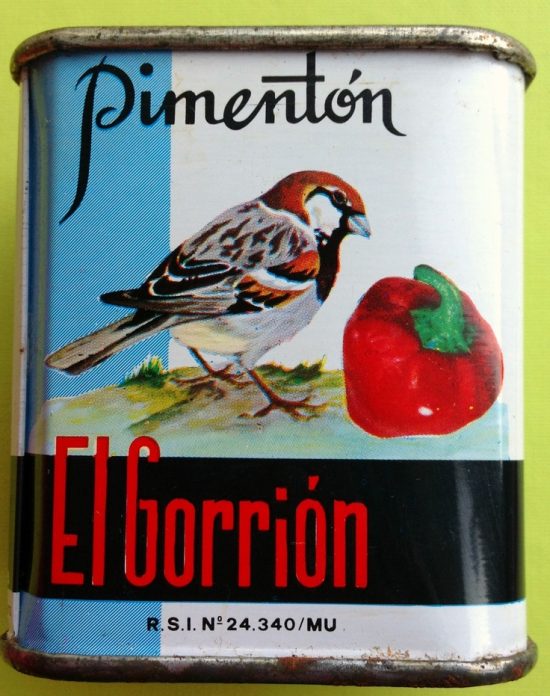
One in a popular series of posts by Tom Nealon, author of Food Fights and Culture Wars: A Secret History of Taste (British Library Publishing, October 2016, and forthcoming in March from Overlook). STUFFED is inspired by Nealon’s collection of rare cookbooks, which he sells — among other things — via Pazzo Books.
STUFFED SERIES: THE MAGAZINE OF TASTE | AUGURIES AND PIGNOSTICATIONS | THE CATSUP WAR | CAVEAT CONDIMENTOR | CURRIE CONDIMENTO | POTATO CHIPS AND DEMOCRACY | PIE SHAPES | WHEY AND WHEY NOT | PINK LEMONADE | EUREKA! MICROWAVES | CULINARY ILLUSIONS | AD SALSA PER ASPERA | THE WAR ON MOLE | ALMONDS: NO JOY | GARNISHED | REVUE DES MENUS | REVUE DES MENUS (DEUX) | WORCESTERSHIRE SAUCE | THE THICKENING | TRUMPED | CHILES EN MOVIMIENTO | THE GREAT EATER OF KENT | GETTING MEDIEVAL WITH CHEF WATSON | KETCHUP & DIJON | TRY THE SCROD | MOCK VENISON | THE ROMANCE OF BUTCHERY | I CAN HAZ YOUR TACOS | STUFFED TURKEY | BREAKING GINGERBREAD | WHO ATE WHO? | LAYING IT ON THICK | MAYO MIXTURES | MUSICAL TASTE | ELECTRIFIED BREADCRUMBS | DANCE DANCE REVOLUTION | THE ISLAND OF LOST CONDIMENTS | FLASH THE HASH | BRUNSWICK STEW: B.S. | FLASH THE HASH, pt. 2 | THE ARK OF THE CONDIMENT | SQUEEZED OUT | SOUP v. SANDWICH | UNNATURAL SELECTION | HI YO, COLLOIDAL SILVER | PROTEIN IN MOTION | GOOD RIDDANCE TO RESTAURANTS.
Foods move around the globe with speed and little enough meaning these days, but the relationship between the U.S. and Mexico has always been close, with a rich history of (mostly northward) food transfers that go back thousands of years, long before there was a U.S. or a Mexico. We have always been bound together; beans, corn, chile, tomato. We are expected to think of America when we see a field of corn waving in the breeze, but why not a field of chiles? In that spirit, here are four chile-containing foods that charted especially interesting paths.
Tacos al Pastor
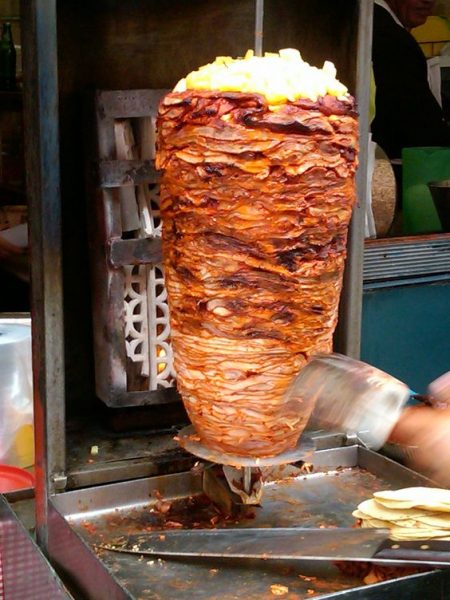
A current favorite on the hipster taco circuit, tacos al pastor replaced carnitas which replaced fish tacos as the taco style del dia. However, it was a longer trip than Michoacán or Baja to Brooklyn for tacos al pastor. In the late 19th and early 20th century, when Lebanon was part of the Ottoman Empire, and later a French Protectorate following WWI, some 100,000 Arabic speakers emigrated to Mexico — the largest numbers from Lebanon, but significant numbers from Syria, Palestine and Iraq. They brought with them their spit-roasted lamb. A large concentration settled in and around Puebla where they added to that city’s rich food history by opening taco stands selling lamb on wheat tortillas. Though who sold the first tacos árabe isn’t quite clear, it is most often attributed to Iraqi immigrants in the 1920s. These days you are more likely (at least outside of Puebla) to find the Mexicanized version developed in the 1950s in Mexico City called tacos al pastor and made from pork (though still the same cylindrical roast) roasted with pineapple and served on corn tortillas. Imagine if those dummies had known this when they were wringing their hands about taco trucks on every corner.
Paprika

One of the original chapters for my book was supposed to be me blowing open the story on paprika — how we’d been bamboozled by the Hungarians into buying mild chile powder made from peppers that just happened to have been grown in Hungary (or, often, as it turns out, Spain) and then shipped back to the United States under an assumed name. It turns out Hungary has been developing their pepper varieties since the 17th century to grow best in their climate and conditions, turning out an incredible variety of peppers from sweet and mild to hotter and more piquant. Like a number of other spots that embraced the chile pepper early as it was introduced from Mexico and South America (Thailand, India, China, Africa, Italy, etc.), they made it their own as it completely changed their cuisine. Of course, in the real world, most paprika really is just lousy powdered chiles, but it looks like it’s not Hungary’s fault. Someday we will find the real culprit.
New Mexico Chiles
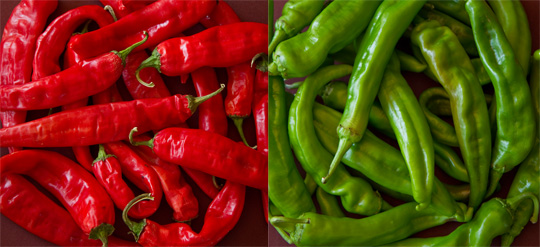
Paprika, in fact, is a similar story to the chile peppers that lie at the center of New Mexican cuisine, but instead of returning to America, the New Mexican chiles became American along with the rest of New Mexico in 1848. Conquistadors travelling north in the 16th century through the Sonoran desert brought a variety of chiles to New Mexico broadening the diversity of varieties that were likely already present across the pueblos. Over the next 300+ years, seeds were selected from ripened fruits that performed well (for the climate, topography, in flavor and heat). These seeds were then used by the agricultural group at New Mexico State University in the late 19th century to work on an ideal crop solution and in 1913 they developed one – “New Mexico No. 9”. In addition to this pepper and similar cultivars, which are justly famed as New Mexico green and red chile and are grown largely in Southern New Mexico, older, more varied peppers are sprinkled throughout the north. These peppers, collectively known as landrace chiles, have been slowly optimized for very specific conditions in high elevation villages and pueblos all over the north – often taking their names from their locations (Chimayó, Cochiti Pueblo, Alcalde, Zia Pueblo etc.), they have survived because they haven’t been commercialized, but grown in small patches, free from cross pollination, and nurtured.
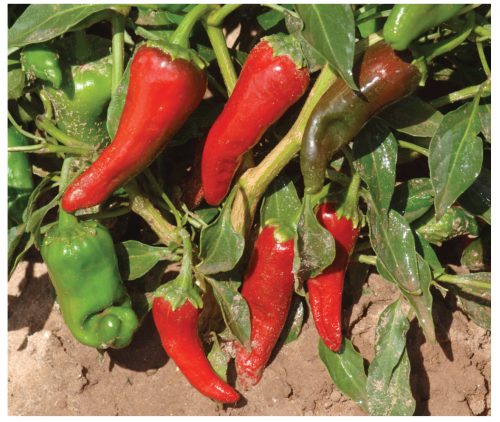
Some may look back and wish that we hadn’t won Texas from Mexico in 1848, but at least we got New Mexico.
Huevos Rancheros
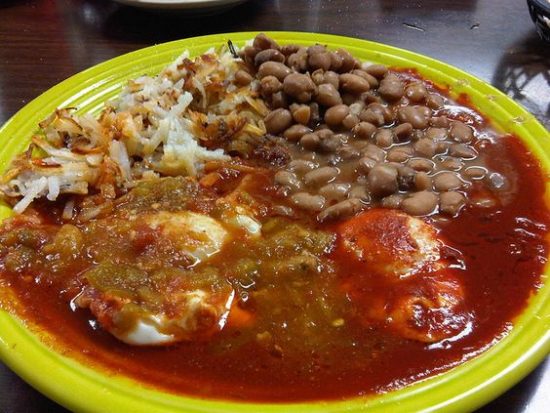
So good! But, along with many other Mexican egg dishes, a relatively recent invention. In the early 20th century, tourist and commercial traffic from the US to Mexico brought the American love of eggs for breakfast to Mexico. Though there were no chickens (only turkeys) before the arrival of the Spanish, Mexicans had added eggs into their diets, but not at the levels consumed by Americans. In 19th century cookbooks you see variations on scrambled and “huevos estrellados” (Spanish fried eggs), some served with a red chile sauce, and omlettes, but that’s about it. It wasn’t until the 20th century that Mexican cooks were forced to come up with an answer to eggs benedict addicted tourists and business travellers. Huevos rancheros, huevos divorciados, and a host of other terrific egg dishes popped up in the first decades of the 20th century — and it didn’t take long for these eggs benedict challengers to be brought to the US to add to groaning breakfast tables.
STUFFED SERIES: THE MAGAZINE OF TASTE | AUGURIES AND PIGNOSTICATIONS | THE CATSUP WAR | CAVEAT CONDIMENTOR | CURRIE CONDIMENTO | POTATO CHIPS AND DEMOCRACY | PIE SHAPES | WHEY AND WHEY NOT | PINK LEMONADE | EUREKA! MICROWAVES | CULINARY ILLUSIONS | AD SALSA PER ASPERA | THE WAR ON MOLE | ALMONDS: NO JOY | GARNISHED | REVUE DES MENUS | REVUE DES MENUS (DEUX) | WORCESTERSHIRE SAUCE | THE THICKENING | TRUMPED | CHILES EN MOVIMIENTO | THE GREAT EATER OF KENT | GETTING MEDIEVAL WITH CHEF WATSON | KETCHUP & DIJON | TRY THE SCROD | MOCK VENISON | THE ROMANCE OF BUTCHERY | I CAN HAZ YOUR TACOS | STUFFED TURKEY | BREAKING GINGERBREAD | WHO ATE WHO? | LAYING IT ON THICK | MAYO MIXTURES | MUSICAL TASTE | ELECTRIFIED BREADCRUMBS | DANCE DANCE REVOLUTION | THE ISLAND OF LOST CONDIMENTS | FLASH THE HASH | BRUNSWICK STEW: B.S. | FLASH THE HASH, pt. 2 | THE ARK OF THE CONDIMENT | SQUEEZED OUT | SOUP v. SANDWICH | UNNATURAL SELECTION | HI YO, COLLOIDAL SILVER | PROTEIN IN MOTION | GOOD RIDDANCE TO RESTAURANTS.
MORE POSTS BY TOM NEALON: Salsa Mahonesa and the Seven Years War, Golden Apples, Crimson Stew, Diagram of Condiments vs. Sauces, etc., and his De Condimentis series (Fish Sauce | Hot Sauce | Vinegar | Drunken Vinegar | Balsamic Vinegar | Food History | Barbecue Sauce | Butter | Mustard | Sour Cream | Maple Syrup | Salad Dressing | Gravy) — are among the most popular we’ve ever published here at HILOBROW.
